Abstract
Inherited susceptibility to rheumatoid arthritis is associated with genes encoding the human major histocompatibility complex class II molecule HLA-DR4. To study the immune function of HLA-DR4 and attempt to generate a murine model of rheumatoid arthritis we have produced triple transgenic mice expressing HLA-DRA*0101, -DRB1*0401, and human CD4. The expression of the HLA transgenes is driven by the promoter of the murine major histocompatibility complex class II I-E alpha gene and was found on murine cells that normally display major histocompatibility complex class II molecules. The expression of the human CD4 transgene is driven by the murine CD3 delta-promoter, and therefore its gene product was found on cells that express murine CD3. In contrast to other HLA-DR and HLA-DQ transgenic mouse lines, the transgenes are functional in our mice. In H-2 I-E-negative transgenic mice, T cells expressing variable region beta chain (V beta) 3, 5, 6, 7, 9, 11, 12, or 13 were either absent or significantly reduced, in contrast to H-2 I-E-negative nontransgenic littermates. In addition, the peptide antigen influenza A virus hemagglutinin 307-319, which binds to the HLA-DRA*0101/-DRB1*0401 heterodimer with high affinity and induces an HLA-DR-restricted and CD4+ T-cell response in humans, also induced a T-cell response in the triple transgenic mice but not in nontransgenic littermates. Thus, these transgenic mice should permit extensive testing of the antigen-presentation capabilities of the HLA-DRA*0101/-DRB1*0401 molecule.
Full text
PDF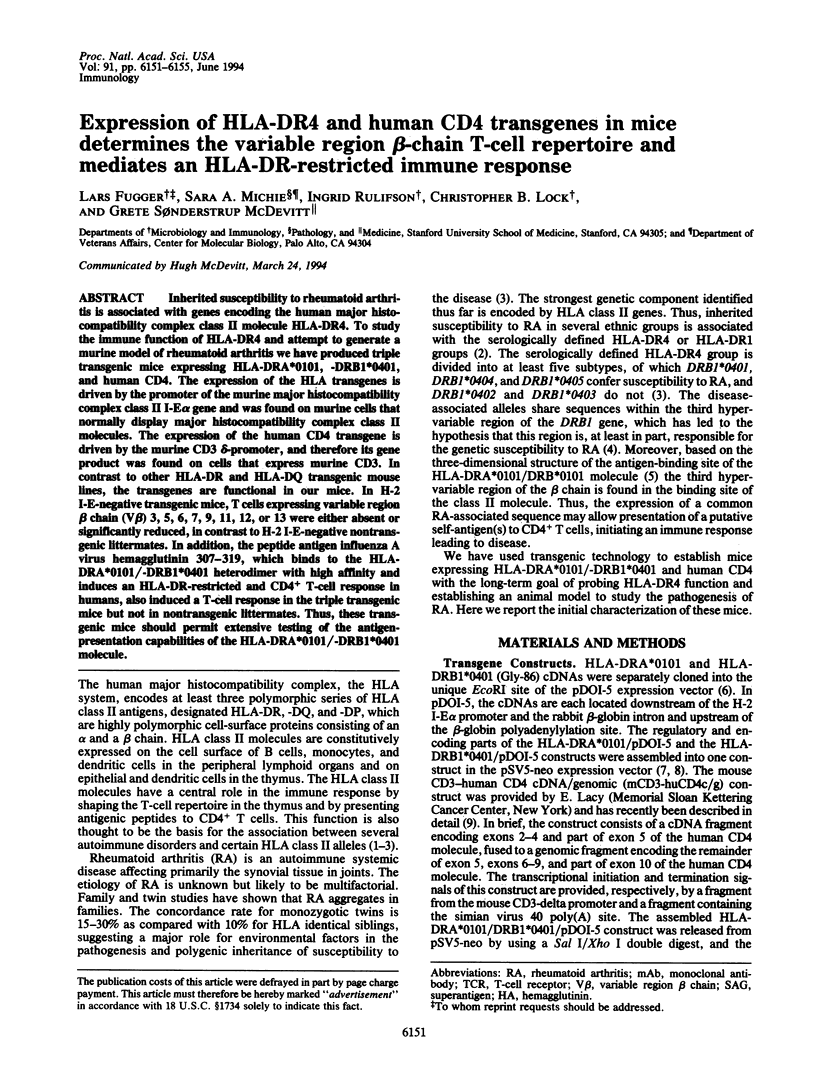
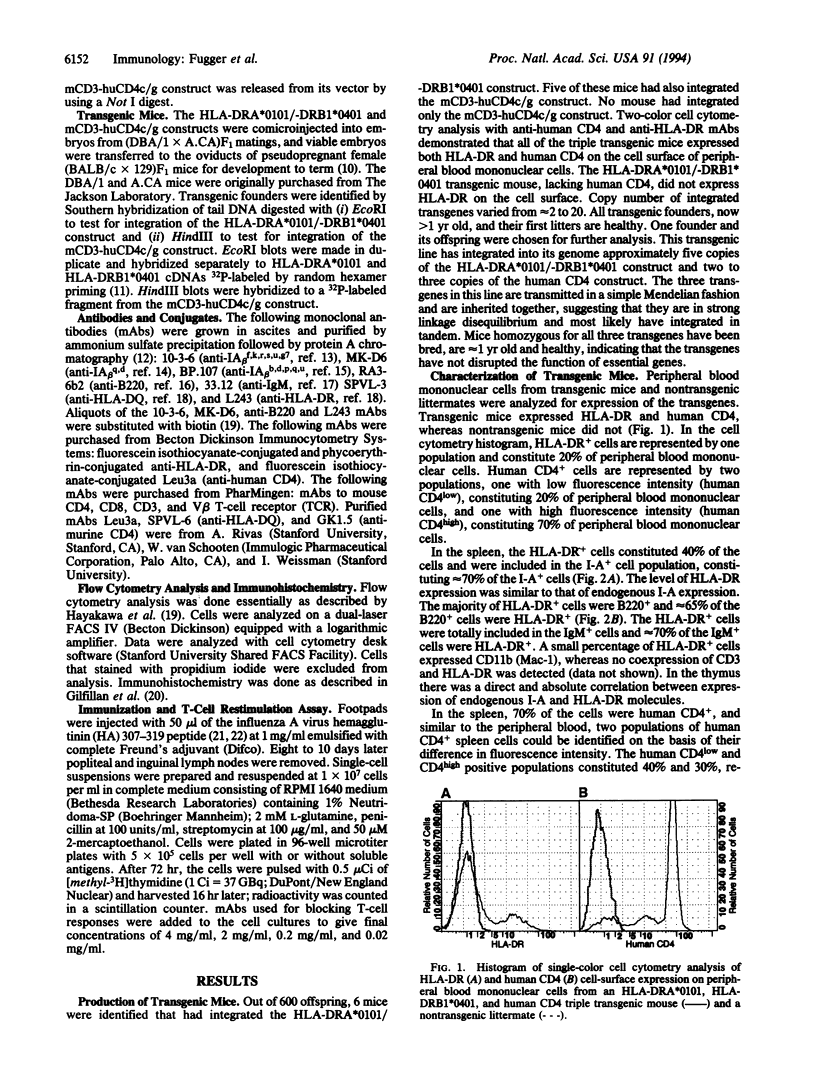
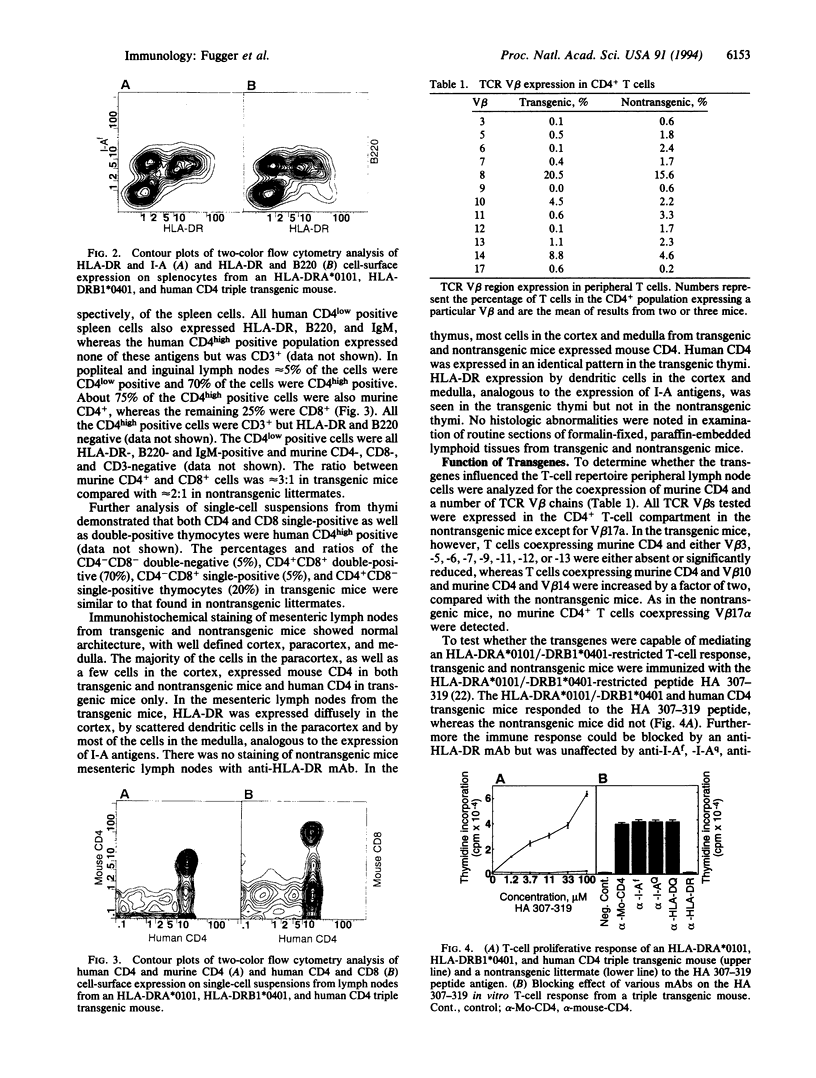
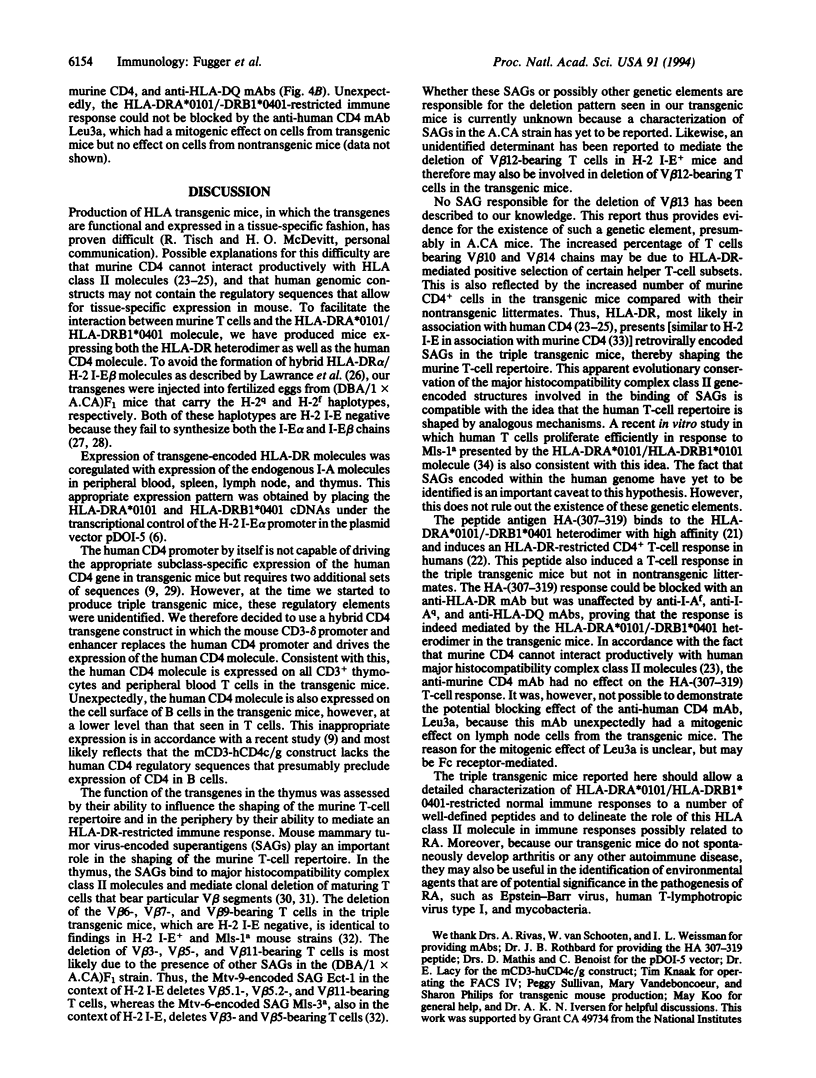
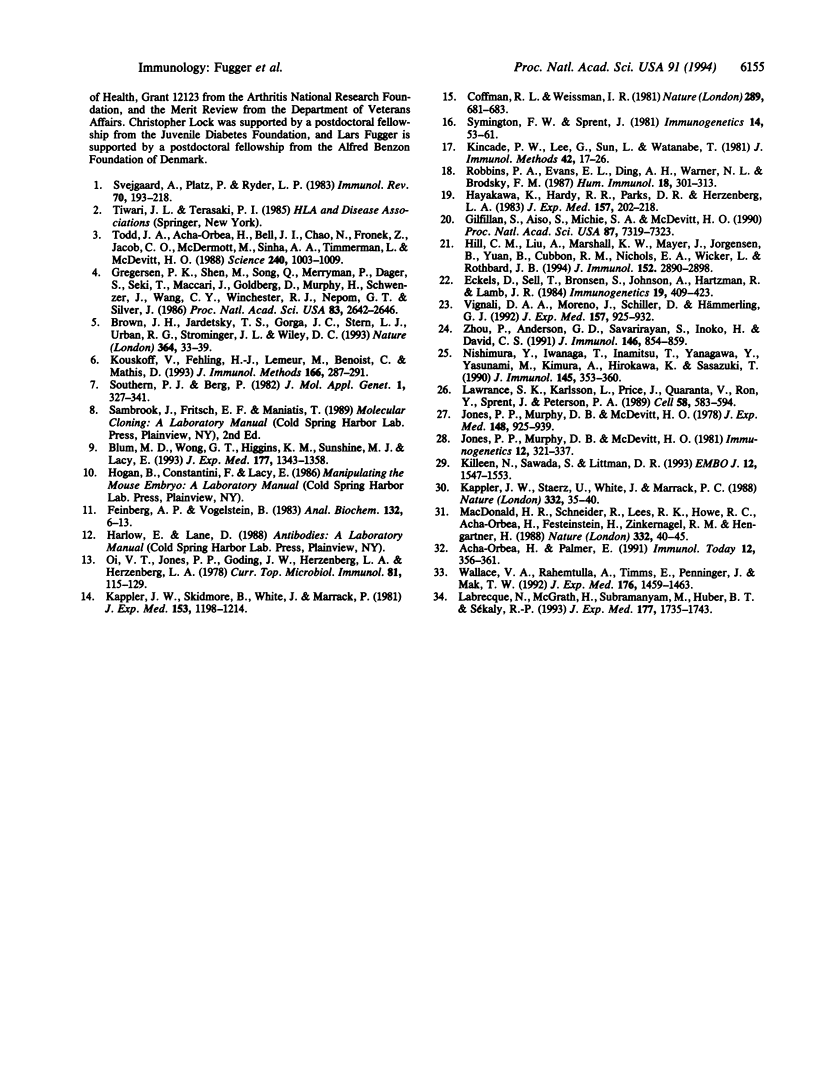
Images in this article
Selected References
These references are in PubMed. This may not be the complete list of references from this article.
- Acha-Orbea H., Palmer E. Mls--a retrovirus exploits the immune system. Immunol Today. 1991 Oct;12(10):356–361. doi: 10.1016/0167-5699(91)90066-3. [DOI] [PubMed] [Google Scholar]
- Blum M. D., Wong G. T., Higgins K. M., Sunshine M. J., Lacy E. Reconstitution of the subclass-specific expression of CD4 in thymocytes and peripheral T cells of transgenic mice: identification of a human CD4 enhancer. J Exp Med. 1993 May 1;177(5):1343–1358. doi: 10.1084/jem.177.5.1343. [DOI] [PMC free article] [PubMed] [Google Scholar]
- Brown J. H., Jardetzky T. S., Gorga J. C., Stern L. J., Urban R. G., Strominger J. L., Wiley D. C. Three-dimensional structure of the human class II histocompatibility antigen HLA-DR1. Nature. 1993 Jul 1;364(6432):33–39. doi: 10.1038/364033a0. [DOI] [PubMed] [Google Scholar]
- Coffman R. L., Weissman I. L. B220: a B cell-specific member of th T200 glycoprotein family. Nature. 1981 Feb 19;289(5799):681–683. doi: 10.1038/289681a0. [DOI] [PubMed] [Google Scholar]
- Eckels D. D., Sell T. W., Bronson S. R., Johnson A. H., Hartzman R. J., Lamb J. R. Human helper T-cell clones that recognize different influenza hemagglutinin determinants are restricted by different HLA-D region epitopes. Immunogenetics. 1984;19(5):409–423. doi: 10.1007/BF00364644. [DOI] [PubMed] [Google Scholar]
- Feinberg A. P., Vogelstein B. A technique for radiolabeling DNA restriction endonuclease fragments to high specific activity. Anal Biochem. 1983 Jul 1;132(1):6–13. doi: 10.1016/0003-2697(83)90418-9. [DOI] [PubMed] [Google Scholar]
- Gilfillan S., Aiso S., Michie S. A., McDevitt H. O. Immune deficiency due to high copy numbers of an Ak beta transgene. Proc Natl Acad Sci U S A. 1990 Sep;87(18):7319–7323. doi: 10.1073/pnas.87.18.7319. [DOI] [PMC free article] [PubMed] [Google Scholar]
- Gregersen P. K., Shen M., Song Q. L., Merryman P., Degar S., Seki T., Maccari J., Goldberg D., Murphy H., Schwenzer J. Molecular diversity of HLA-DR4 haplotypes. Proc Natl Acad Sci U S A. 1986 Apr;83(8):2642–2646. doi: 10.1073/pnas.83.8.2642. [DOI] [PMC free article] [PubMed] [Google Scholar]
- Hayakawa K., Hardy R. R., Parks D. R., Herzenberg L. A. The "Ly-1 B" cell subpopulation in normal immunodefective, and autoimmune mice. J Exp Med. 1983 Jan 1;157(1):202–218. doi: 10.1084/jem.157.1.202. [DOI] [PMC free article] [PubMed] [Google Scholar]
- Hill C. M., Liu A., Marshall K. W., Mayer J., Jorgensen B., Yuan B., Cubbon R. M., Nichols E. A., Wicker L. S., Rothbard J. B. Exploration of requirements for peptide binding to HLA DRB1*0101 and DRB1*0401. J Immunol. 1994 Mar 15;152(6):2890–2898. [PubMed] [Google Scholar]
- Jones P. P., Murphy D. B., McDevitt H. O. Two-gene control of the expression of a murine Ia antigen. J Exp Med. 1978 Oct 1;148(4):925–939. doi: 10.1084/jem.148.4.925. [DOI] [PMC free article] [PubMed] [Google Scholar]
- Jones P. P., Murphy D. B., McDevitt H. O. Variable synthesis and expression of E alpha and Ae (E beta) Ia polypeptide chains in mice of different H-2 haplotypes. Immunogenetics. 1981;12(3-4):321–337. doi: 10.1007/BF01561674. [DOI] [PubMed] [Google Scholar]
- Kappler J. W., Skidmore B., White J., Marrack P. Antigen-inducible, H-2-restricted, interleukin-2-producing T cell hybridomas. Lack of independent antigen and H-2 recognition. J Exp Med. 1981 May 1;153(5):1198–1214. doi: 10.1084/jem.153.5.1198. [DOI] [PMC free article] [PubMed] [Google Scholar]
- Kappler J. W., Staerz U., White J., Marrack P. C. Self-tolerance eliminates T cells specific for Mls-modified products of the major histocompatibility complex. Nature. 1988 Mar 3;332(6159):35–40. doi: 10.1038/332035a0. [DOI] [PubMed] [Google Scholar]
- Killeen N., Sawada S., Littman D. R. Regulated expression of human CD4 rescues helper T cell development in mice lacking expression of endogenous CD4. EMBO J. 1993 Apr;12(4):1547–1553. doi: 10.1002/j.1460-2075.1993.tb05798.x. [DOI] [PMC free article] [PubMed] [Google Scholar]
- Kincade P. W., Lee G., Sun L., Watanabe T. Monoclonal rat antibodies to murine IgM determinants. J Immunol Methods. 1981;42(1):17–26. doi: 10.1016/0022-1759(81)90220-9. [DOI] [PubMed] [Google Scholar]
- Kouskoff V., Fehling H. J., Lemeur M., Benoist C., Mathis D. A vector driving the expression of foreign cDNAs in the MHC class II-positive cells of transgenic mice. J Immunol Methods. 1993 Dec 3;166(2):287–291. doi: 10.1016/0022-1759(93)90370-m. [DOI] [PubMed] [Google Scholar]
- Labrecque N., McGrath H., Subramanyam M., Huber B. T., Sékaly R. P. Human T cells respond to mouse mammary tumor virus-encoded superantigen: V beta restriction and conserved evolutionary features. J Exp Med. 1993 Jun 1;177(6):1735–1743. doi: 10.1084/jem.177.6.1735. [DOI] [PMC free article] [PubMed] [Google Scholar]
- Lawrance S. K., Karlsson L., Price J., Quaranta V., Ron Y., Sprent J., Peterson P. A. Transgenic HLA-DR alpha faithfully reconstitutes IE-controlled immune functions and induces cross-tolerance to E alpha in E alpha 0 mutant mice. Cell. 1989 Aug 11;58(3):583–594. doi: 10.1016/0092-8674(89)90439-x. [DOI] [PubMed] [Google Scholar]
- MacDonald H. R., Schneider R., Lees R. K., Howe R. C., Acha-Orbea H., Festenstein H., Zinkernagel R. M., Hengartner H. T-cell receptor V beta use predicts reactivity and tolerance to Mlsa-encoded antigens. Nature. 1988 Mar 3;332(6159):40–45. doi: 10.1038/332040a0. [DOI] [PubMed] [Google Scholar]
- Nishimura Y., Iwanaga T., Inamitsu T., Yanagawa Y., Yasunami M., Kimura A., Hirokawa K., Sasazuki T. Expression of the human MHC, HLA-DQW6 genes alters the immune response in C57BL/6 mice. J Immunol. 1990 Jul 1;145(1):353–360. [PubMed] [Google Scholar]
- Oi V. T., Jones P. P., Goding J. W., Herzenberg L. A., Herzenberg L. A. Properties of monoclonal antibodies to mouse Ig allotypes, H-2, and Ia antigens. Curr Top Microbiol Immunol. 1978;81:115–120. doi: 10.1007/978-3-642-67448-8_18. [DOI] [PubMed] [Google Scholar]
- Robbins P. A., Evans E. L., Ding A. H., Warner N. L., Brodsky F. M. Monoclonal antibodies that distinguish between class II antigens (HLA-DP, DQ, and DR) in 14 haplotypes. Hum Immunol. 1987 Apr;18(4):301–313. doi: 10.1016/0198-8859(87)90077-2. [DOI] [PubMed] [Google Scholar]
- Southern P. J., Berg P. Transformation of mammalian cells to antibiotic resistance with a bacterial gene under control of the SV40 early region promoter. J Mol Appl Genet. 1982;1(4):327–341. [PubMed] [Google Scholar]
- Svejgaard A., Platz P., Ryder L. P. HLA and disease 1982--a survey. Immunol Rev. 1983;70:193–218. doi: 10.1111/j.1600-065x.1983.tb00715.x. [DOI] [PubMed] [Google Scholar]
- Symington F. W., Sprent J. A monoclonal antibody detecting an Ia specificity mapping in the I-A or I-E subregion. Immunogenetics. 1981;14(1-2):53–61. doi: 10.1007/BF00344299. [DOI] [PubMed] [Google Scholar]
- Todd J. A., Acha-Orbea H., Bell J. I., Chao N., Fronek Z., Jacob C. O., McDermott M., Sinha A. A., Timmerman L., Steinman L. A molecular basis for MHC class II--associated autoimmunity. Science. 1988 May 20;240(4855):1003–1009. doi: 10.1126/science.3368786. [DOI] [PubMed] [Google Scholar]
- Vignali D. A., Moreno J., Schiller D., Hämmerling G. J. Species-specific binding of CD4 to the beta 2 domain of major histocompatibility complex class II molecules. J Exp Med. 1992 Apr 1;175(4):925–932. doi: 10.1084/jem.175.4.925. [DOI] [PMC free article] [PubMed] [Google Scholar]
- Wallace V. A., Rahemtulla A., Timms E., Penninger J., Mak T. W. CD4 expression is differentially required for deletion of MLS-1a-reactive T cells. J Exp Med. 1992 Nov 1;176(5):1459–1463. doi: 10.1084/jem.176.5.1459. [DOI] [PMC free article] [PubMed] [Google Scholar]
- Zhou P., Anderson G. D., Savarirayan S., Inoko H., David C. S. Thymic deletion of V beta 11+, V beta 5+ T cells in H-2E negative, HLA-DQ beta+ single transgenic mice. J Immunol. 1991 Feb 1;146(3):854–859. [PubMed] [Google Scholar]




